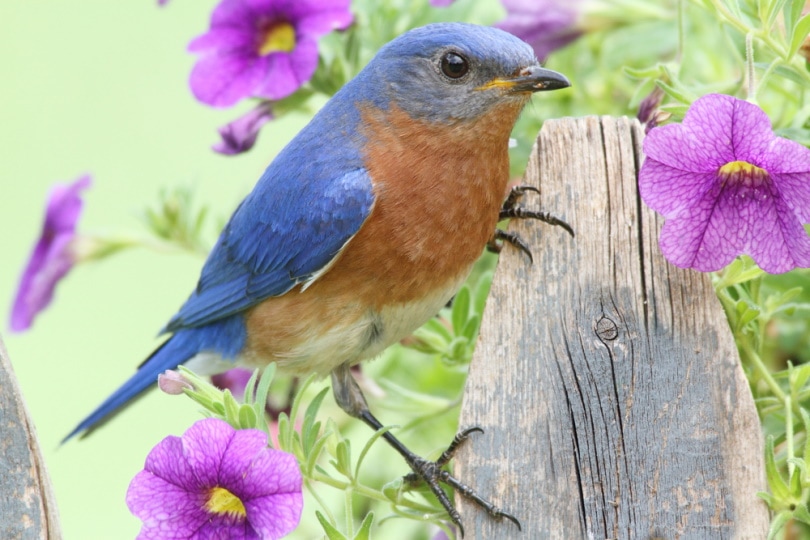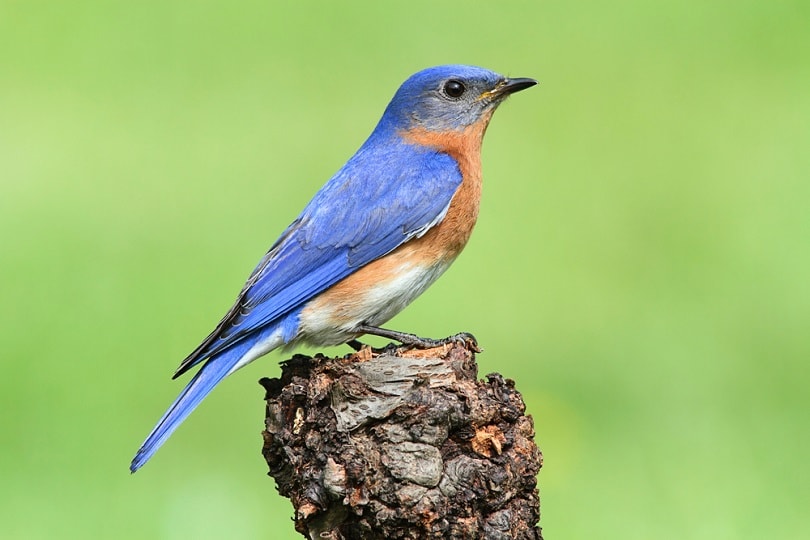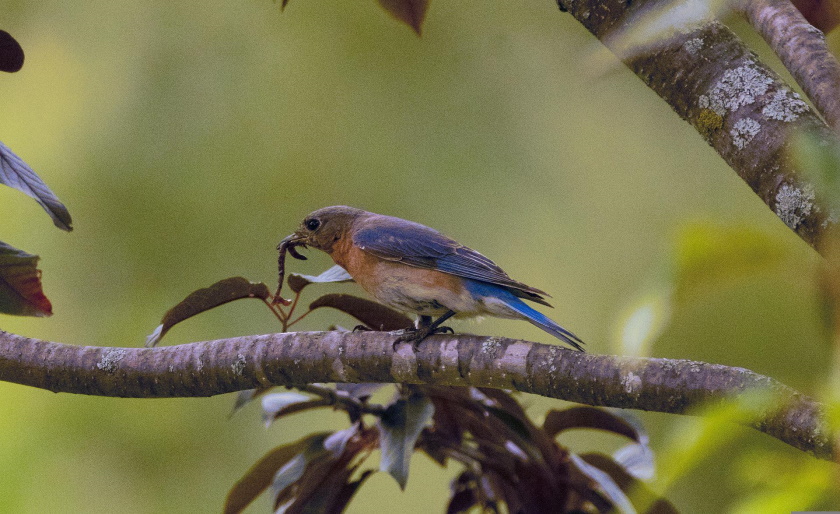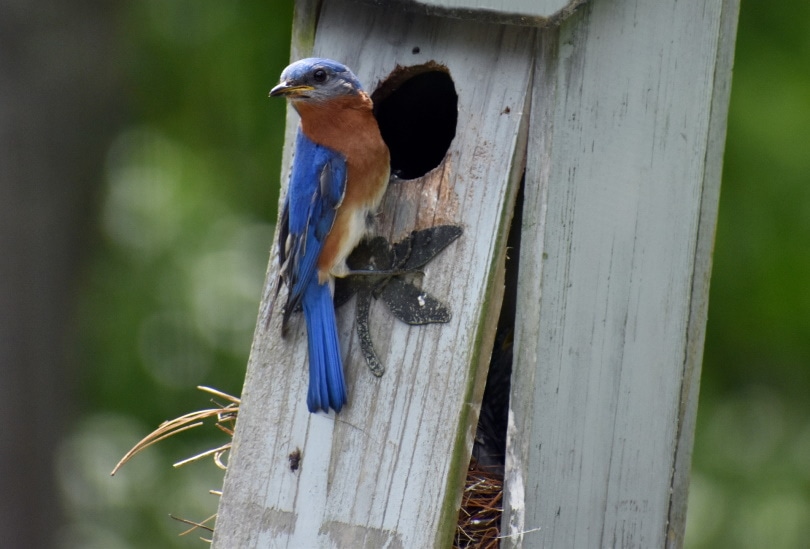What is the State Bird of Missouri? How Was it Decided?
Last Updated on

From the beautiful Flowering Dogwood to the strong and sturdy Missouri Mule, the Show-Me State has many symbols that represent its statehood. If you are wondering what the official state bird of Missouri is, that answer is the vibrant and lively Eastern Bluebird. So, what exactly makes this bird so special that it became a state symbol? Read on and we’ll give you all the details.

The Eastern Bluebird
The Eastern Bluebird, known by the scientific name Sialia sialis, is one of the three species of bluebird found in North America. This species is the most widespread of the bluebirds and are permanent residents of the Southern United States. They will spend time in the Northern regions from early spring to late fall before migrating south.
The Eastern Bluebird suffered severe population decline in the early 20th century due to habitat loss that resulted from a combination of land development and the invasion of non-native House Sparrows and European Starlings. These birds were imported purposely and as fellow cavity nesters, they took over the Eastern Bluebirds’ habitat and suitable nesting cavities.
Thankfully, the species made a comeback and is now considered Least Concern in conservation status thanks to the due diligence of those that provided the education and resources to others to help the species restore their habitat and numbers.

Appearance
| Weight | 95 -1.2 oz |
| Length | 3 – 8.3 inches |
| Wingspan | 10-13 inches |
The Eastern Bluebird is about two-thirds the size of the American Robin. They have plump bodies and rounded heads with large, dark eyes and a short, straight bill. They are longer winged with shorter legs and tails.
The male Eastern Bluebird is vibrantly colored with royal blue plumage on their heads, backs, and wings with a rusty to deep-orange coloration on the throat and breast area, and white along their underside.
The females are duller in color with grey along with their heads and backs and blue coloration on the wings and tail. Like the males, they have orange coloration along the throat and breast area– though it’s a lighter, duller shade — and white coloration along the underside.

Habitat and Migration
The range of the Eastern Bluebird extends from Eastern North America to as far south as Nicaragua. Their time spent in the Northeast is migratory during the breeding season, as they spend their winters in the south.
Their breeding season begins as early as February in more southern states within the U.S. In Missouri, they are found statewide during the breeding season but can be found in the southern portion of the state year-round.
Eastern Bluebirds are cavity nesters that are found in meadows, along forest edges, and in open country areas surrounded by trees, which offer prime nesting. These birds are commonly seen perched on fence posts and trees. They are also common in backyards and will frequent man-made nesting boxes. They are not drawn in by feeders unless mealworms are offered.

Diet and Feeding Behavior
The Eastern Bluebirds’ diet consists primarily of insects and fruits. As far as insects go, they feed on a variety including beetles, crickets, caterpillars, and grasshoppers. They are also known for occasionally feeding on earthworms, spiders, and snails.
They primarily feast on the insects during the warmer weather seasons when they are readily available. Once the winter hits they gravitate more toward available fruits such as berries, grapes, and fruits from sumac, dogwood, hackberry, pokeweed, poison ivy, and other fruit-bearing plants.
Though they are known for catching insects in mid-air, they typically forage by either perching or hovering over the ground to catch insects or hovering near foliage to grab up their preferred fruits.

Reproduction and Nesting
Though the breeding season can begin as early as February, it typically starts sometime between March and April. Males will select a suitable territory and will then begin singing and showing off their brightly colored blue plumage by fluttering around with their wings and tail spread to attract a female.
Since Eastern Bluebirds are cavity nesters, they will nest in either the cavity of a hollow tree, an old woodpecker hole, or a man-made birdhouse. The female will lay anywhere from 2 to 7 eggs but 4 to 5 per brood is typical. Females typically have 2 to 3 broods per season. The incubation period for the eggs lasts approximately 13 to 16 days.
Once hatched, the nestlings will be cared for and fed by both parents and sometimes even the young ones from a previous brood. After around 18 or 19 days, the little ones will leave the nest and go out on their own.

Origins of the State Bird of Missouri
The Eastern Bluebird became the official state bird of Missouri in 1927. It was one of the earliest state symbols established for the state, predated only by the state seal in 1822, the state motto “Salus Populi Suprema Lex Esto” also established in 1822, and the state floral emblem, the white hawthorn blossom in 1923.
It was chosen as a state symbol for a couple of reasons. The species is common in Missouri, being found all over the state from early spring to late fall with some permanent residents in the southern portion of the state. It only made sense that the bird chosen to symbolize the “Show Me” state was to show itself regularly within the state’s boundaries.
The other reason the Eastern Bluebird was chosen as Missouri’s state bird is that it is considered a symbol of happiness with its beautiful song and the male’s vibrant, Americana coloration.

Observing the Eastern Bluebird in Missouri
As mentioned, the Eastern Bluebird can be found in Missouri all year long in the southern portion of the state and can be observed statewide from early spring to late fall, typically in March through November. You may notice these brilliant bluebirds perched in trees or on fence posts with an alert posture along the roadsides or in open areas.
They can easily be invited onto your property if birdhouses are available for nesting. You can simply install some nest boxes on your land and ensure they are ready by mid-February. If you have any dead or dying trees on your property, keep them in place, as these are prime nesting locations.
They do not typically frequent bird feeders because of their diet of insects and berries. If you wish to attract them, try adding mealworms to the feeder and ensure you have fresh water available on your property.

Conclusion
The Eastern Bluebird was named the official state bird of Missouri in 1927, making it the fourth state symbol established by the Show Me State. It received its state symbol status for being a symbol of happiness and a common and very beautiful bird found within the state.
Featured Image Credit: Steve Byland, Shutterstock
About the Author Robert Sparks
Robert’s obsession with all things optical started early in life, when his optician father would bring home prototypes for Robert to play with. Nowadays, Robert is dedicated to helping others find the right optics for their needs. His hobbies include astronomy, astrophysics, and model building. Originally from Newark, NJ, he resides in Santa Fe, New Mexico, where the nighttime skies are filled with glittering stars.
Related Articles:
How to Choose Binoculars for Bird Watching: 10 Expert Tips
10 Types of Hummingbirds in Arkansas (With Pictures)
8 Types of Hummingbirds in Nebraska (With Pictures)
5 Types of Hummingbirds in Idaho (With Pictures)
3 Types of Hummingbirds in Mississippi (With Pictures)
8 Types of Hummingbirds in Kansas (With Pictures)
5 Types of Hummingbirds in West Virginia (With Pictures)
5 Types of Hummingbirds in Ohio (With Pictures)
